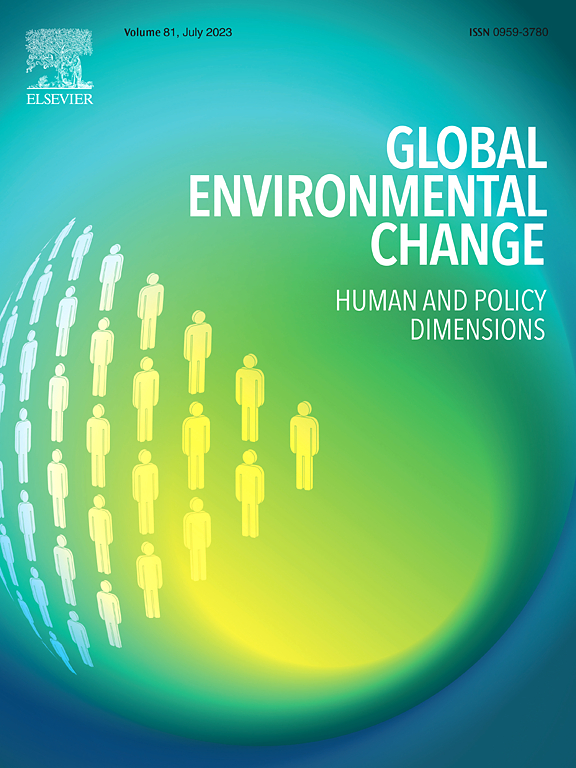土著妇女是 "Pachamama 的守护者":领土主权是秘鲁公正适应气候变化的必要条件
IF 9.1
1区 环境科学与生态学
Q1 ENVIRONMENTAL SCIENCES
引用次数: 0
摘要
对于全球最脆弱的国家而言,针对边缘化人群的变革性气候变化适应规划日益重要。2021 年,秘鲁成为拉丁美洲第一个将性别平等和土著人民平台(PPICC)纳入其国家气候变化适应计划的国家。与此同时,秘鲁还增加了铜等重要矿产的开采量,以应对全球通过绿色能源转型来减缓气候变化的趋势。注重公平的适应规划与主要发生在土著领地的开采之间的不协调在适应文献中未得到充分研究。这对土著妇女尤为重要,因为气候变化和采掘活动双重破坏了她们与领地的联系。本文通过对秘鲁国家适应规划的案例研究,分析了解决土著性和性别问题的适应规划与通过绿色技术减缓气候变化的日益增长的 "采掘需求 "之间的矛盾。基于对土著妇女组织的演讲、访谈和政策建议--以及秘鲁政府和多边机构的规划文件--的专题分析,我表明秘鲁的土著妇女领袖正在利用对领土的体现性诉求和对开采的抵制,将适应规划重新塑造成一个以土著主权为中心的空间。归根结底,秘鲁政府的适应愿景未能考虑到当前针对土著妇女的暴力来源,如采矿,这些暴力破坏了土著妇女的适应能力。我的结论是,将性别和原住民性纳入适应规划主流的努力必须将主权放在首位,以避免开采造成的不良适应结果。本文章由计算机程序翻译,如有差异,请以英文原文为准。
Indigenous women are the “guardians of Pachamama”: Territorial sovereignty is indispensable for just climate change adaptations in Peru
Transformative climate change adaptation planning that addresses marginalized populations is increasingly critical for the globe’s most vulnerable countries. In 2021, Peru became the first country in Latin America to incorporate both gender and an Indigenous peoples’ platform (PPICC) into its national climate change adaptation plan. Peru has simultaneously increased its mining production of critical minerals like copper to address the global push to mitigate climate change through the green energy transition. The dissonance between equity-focused adaptation planning and extraction that occurs largely in Indigenous territories is understudied in the adaptation literature. This is especially pertinent for Indigenous women, whose embodied connection to territory is doubly disrupted by climate change and extractive activities. This paper uses the case study of national adaptation planning in Peru to analyze the tension between adaptation that addresses Indigeneity and gender and the increased “extraction imperative” to mitigate climate change through green technology. Based on a thematic analysis of Indigenous women’s organizations’ speeches, interviews, and policy recommendations—as well as planning documents from the Peruvian state and multilaterals—I show that Indigenous women leaders in Peru are drawing on embodied claims to territory and resistance to extraction to re-make adaptation planning into a space that centers Indigenous sovereignty. Ultimately, the Peruvian state’s vision of adaptation fails to account for ongoing sources of violence against Indigenous women, such as mining, that undermine adaptive capacity. I conclude that efforts to mainstream gender and Indigeneity into adaptation planning must foreground sovereignty to avoid maladaptive outcomes from extraction.
求助全文
通过发布文献求助,成功后即可免费获取论文全文。
去求助
来源期刊

Global Environmental Change
环境科学-环境科学
CiteScore
18.20
自引率
2.20%
发文量
146
审稿时长
12 months
期刊介绍:
Global Environmental Change is a prestigious international journal that publishes articles of high quality, both theoretically and empirically rigorous. The journal aims to contribute to the understanding of global environmental change from the perspectives of human and policy dimensions. Specifically, it considers global environmental change as the result of processes occurring at the local level, but with wide-ranging impacts on various spatial, temporal, and socio-political scales.
In terms of content, the journal seeks articles with a strong social science component. This includes research that examines the societal drivers and consequences of environmental change, as well as social and policy processes that aim to address these challenges. While the journal covers a broad range of topics, including biodiversity and ecosystem services, climate, coasts, food systems, land use and land cover, oceans, urban areas, and water resources, it also welcomes contributions that investigate the drivers, consequences, and management of other areas affected by environmental change.
Overall, Global Environmental Change encourages research that deepens our understanding of the complex interactions between human activities and the environment, with the goal of informing policy and decision-making.
 求助内容:
求助内容: 应助结果提醒方式:
应助结果提醒方式:


